Distributed Systems
"Governments of the Industrial World, you weary giants of flesh and steel, I come from Cyberspace, the new home of Mind. On behalf of the future, I ask you of the past to leave us alone. You are not welcome among us. You have no sovereignty where we gather."
from A Declaration of the Independence of Cyberspace by John Perry Barlow
We live in a time where the institutional foundations of our society seem increasingly in doubt, and arriving at a consensus on truth and reality seems more difficult than ever. As our commitment to the post-war economic order is questioned, and the social contract of the state redefined, we find little help in building a more equitable society from the corporations of Silicon Valley that a free cyberspace has birthed. Now Blockchain based technologies threaten to further disrupt and decentralize our concepts of global governance and economy. While much is being said about the improvements these technologies will bring, why will their effects turn out differently from the open web? How do we promote a better society for people while handing the steering wheel further over to machines?
With this year's special look at Distributed Systems and Blockchain, we present a number of subversive interventions against technological control along with the largest collection of Blockchain based artworks ever assembled on the West Coast. The artists in this exhibition offer looks at the possibility of technology to still make space for free culture, allow freedom from surveillance, and help us retain agency. Through the creative exploration of some of the most cutting-edge, and least understood, systems of global infrastructure today, they find sites of trauma ahead, and fissures where progress is still possible.
Featured Works
Bail Bloc
Grayson Earle, Maya Binyam, Francis Tseng, JB Rubinovitz, Sam Lavigne, Devin Kenny, and the Dark Inquiry collective

Bail Bloc is a cryptocurrency scheme against bail.
Its software uses idle processing power on your computer to mine for cryptocurrency, which is then used to help people awaiting trial who can’t afford to post bail.
When you download the app, a small part of your computer's unused processing power is redirected toward mining a popular cryptocurrency called Monero, which is secure, private, and untraceable. At the end of every month, the Monero is exchanged for US dollars and donate the earnings to the Bronx Freedom Fund.
Blacklists
DISNOVATION.ORG

The Blacklists project is a directory of the prohibitions of the Internet deployed in the form of an encyclopedia in 13 volumes of 666 pages each. It is an extensive collection of restricted websites used for the automatic filtering of traffic considered illicit or licentious.
Just like the intent of «forbidden libraries» for books, the Blacklists project points out the sidelining of online content that could be dangerous for the very survival of the system. With around 2 millions websites extracted from commercial content-control softwares, this collection reveals a cultural, social and ideological model of our society through what should not be seen.
CONCEPTION: DISNOVATION.ORG
BOOKS, DATABASE, INSTALLATION | 2016
Can You Hear Me?
Christoph Wachter & Mathias Jud
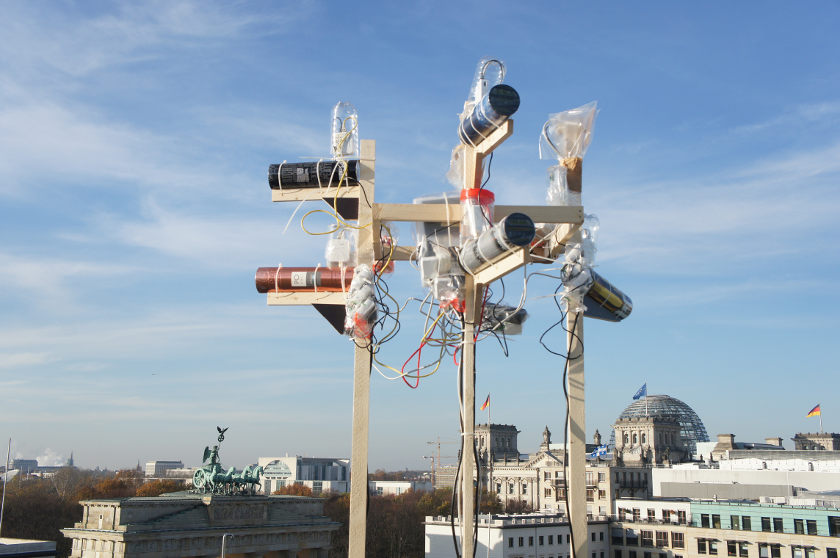
Messages can be sent to the intelligence agencies on the frequencies that are intercepted by the NSA and GCHQ. An independent mesh network in Berlin's Government District recaptured the virtual communication space. A collective conversation space in which all have equal rights has been taking the space of secret wiretapping.
Between the US Embassy and the British Embassy, Christoph Wachter and Mathias Jud have designed up the art project "Can you hear me?". A year ago, due to the revelations of Edward Snowden, this very place became a political focal point. From there, the British and the Americans were spying on the government and the people in Berlin.
Public protests went on without consequences. Instead, oppression became rather widespread. Ironically, the digital media means of expression that were considered, at the beginning of the Egyptian, Tunisian, or Turkish rebellions as promising tools were perverted into their opposite. The digital space which should allow democratic debate is fundamentally manipulated. Because of that, cultural, political, and communicative structures are also shaken and it leads to an experience not unlike the one experienced by people even under authoritarian and restrictive regimes, and a grueling dependence and speechlessness arises.
Claves Angelicae
Cullen Miller & Gabriel Dunne
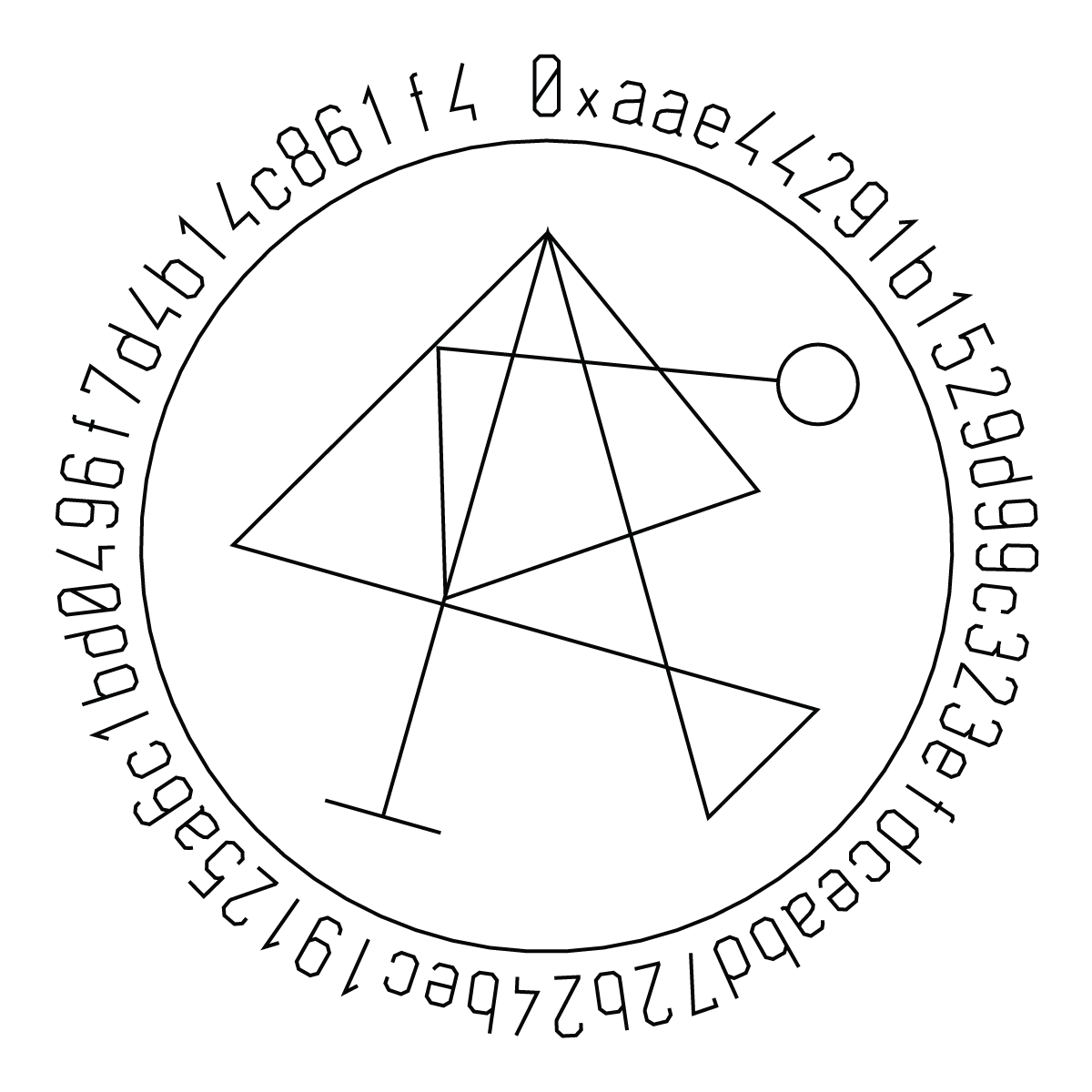
Claves Angelicæ is an installation and procedural system that enables a participant to inscribe a magical Word onto the Ethereum network.
The seven step process is designed to collect and transmute the participants’ input data into an encrypted message. For the participant to cast their Word they must transmit Ether to a preselected set of charities. Once the spell has been cast and verified by the consensus pool, the transaction signature’s hash is returned, parsed, and passed into a sigil generating algorithm. The participant receives an inked paper talisman authored by a mechanical drawing machine as a tokenized sigil of their spell.
Cryptography and magic have a deep, intertwined history dating back to the origins of writing. During the European dark ages monastic sects bore the responsibility of keeping the rites of the sacred ancient mystery cults of Egypt and Greece intact. However, in doing so they ran the risk of being burned at the stake for committing crimes of heresy. Some of them developed cryptographic systems to encode these secrets into their manuscripts. It was not only the monks working with ciphers but also natural magicians and occultists. The latter groups weren’t only using cryptography to obfuscate sensitive information, but also to devise keys and linguistic frameworks for communicating into the Ethereal realms. By devising new linguistic schemata these magicians believed that they could access the preternatural realms outside the worlds they were exploring in their scientific pursuits. Although the blockchain space is largely secularized, the principles of the Ethereum network are a manifest dream of the ancient magi.
Clickmine
Sarah Friend
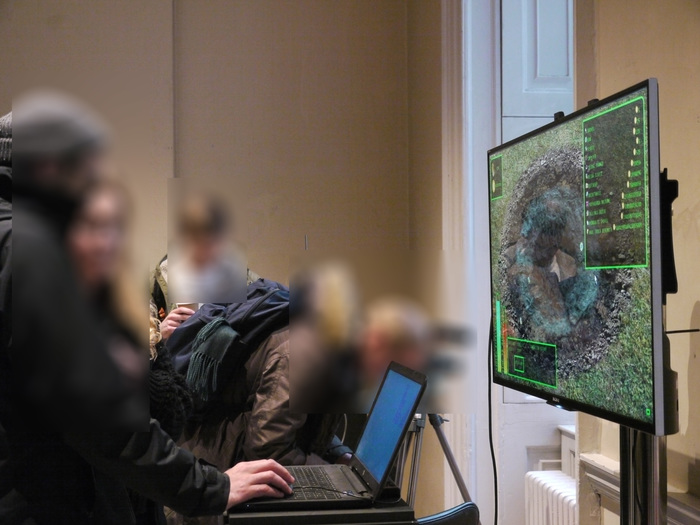
clickmine is a blockchain based clicker game. With each click, you "mine" a virtual plot of land and an ERC 20 token on the Ethereum network is minted. But what is a token, anyway? As wealth is created, it is also destroyed.
clickMine was the recipient of the Cryptodetectorist co-commision by Furtherfield UK and NEoN Digital Arts Festival. It was exhibited at the NEoN Digital Arts Festival in Dundee Scotland November 2017 at MoneyLab in London UK in January 2018.
Crypto Futures Game of Life Board Overprint Collage
Simon Denny
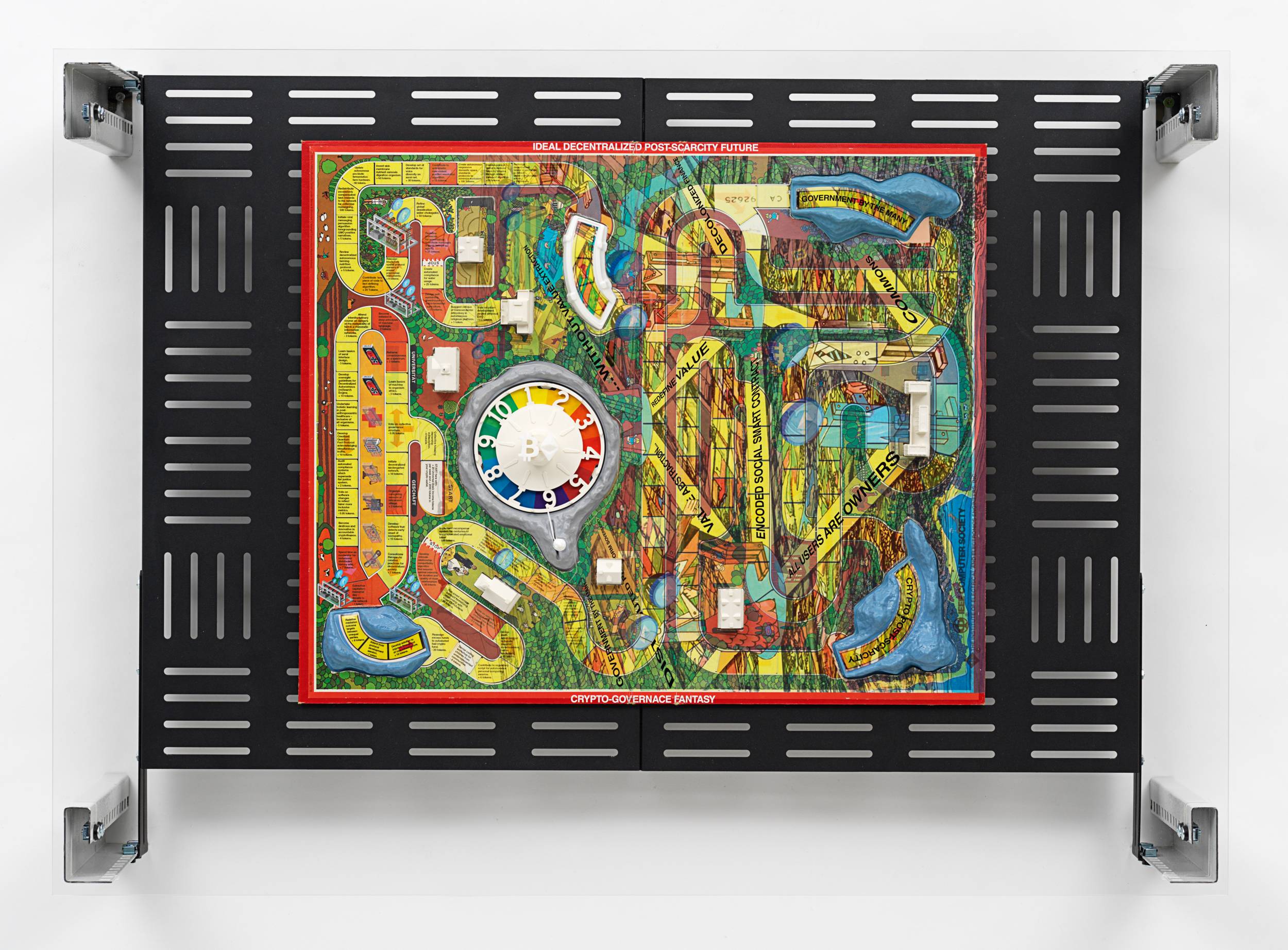
Courtesy of Altman Siegel Gallery
2018
digital print on Milton Bradley’s Game of Life 1976 vintage board, powder-coated server rack shelving, laser cut Plexiglas, various server rack hardware components
72 x 100 x 23 cm
Flowertokens
Paul Kolling, Paul Seidler, Max Hampshire, Andi Rueckel, Gregor Finger & Johannes Wilke
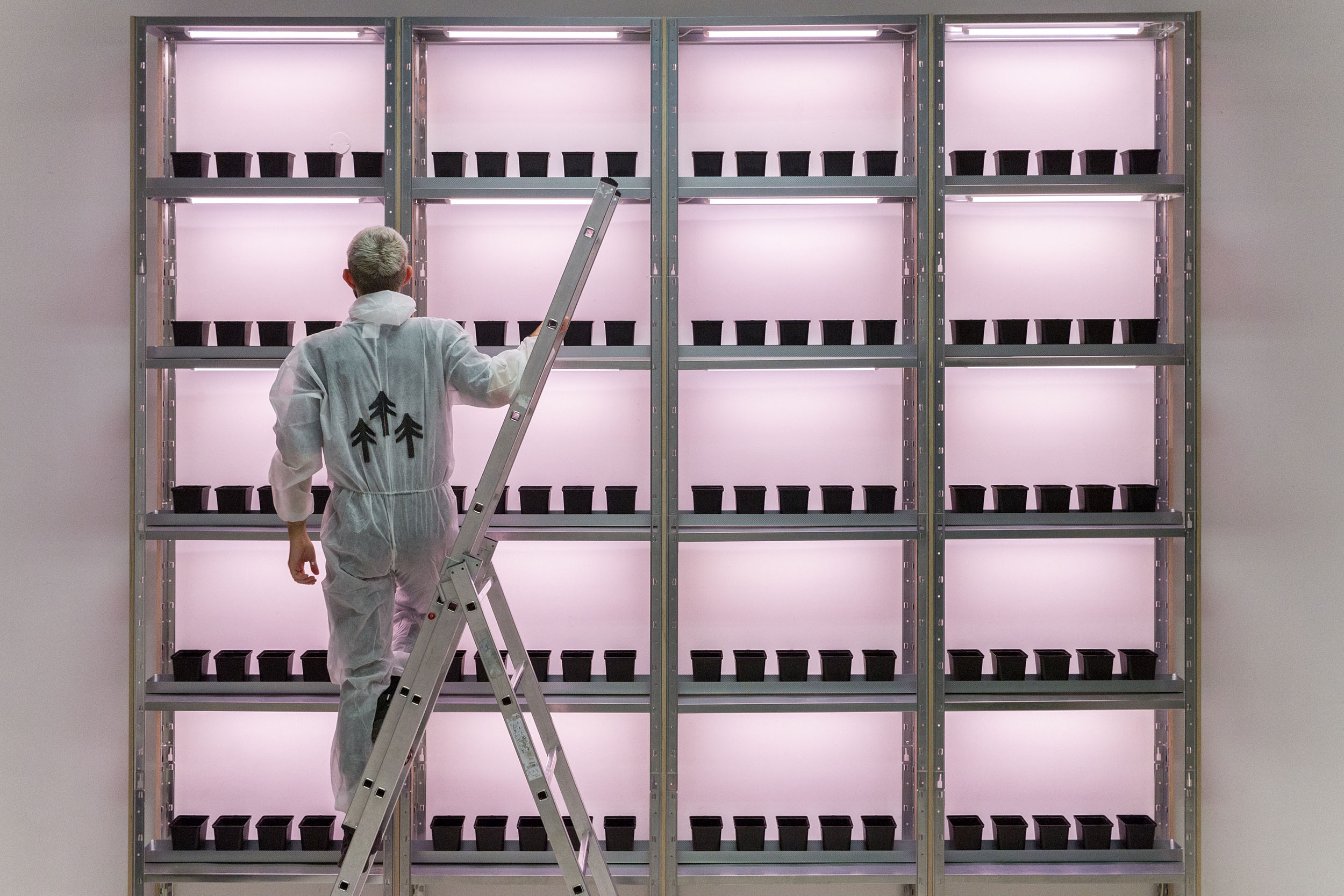
Flowertokens is an experimental project centered around the tokenization and verification of natural commodities, and a first attempt at creating a combined crypto-collectible physical asset.
Users will be able to buy, trade, and speculate on tokenized Freesias (familie Iridaceae) via an online marketplace. The state of the individual tokens will be automatically updated according to the different phases of their corresponding plant’s growth.
Flowertokens further marks the beginning of a series of projects oriented around these themes from terra0 – a group of developers and researchers involved in the planning and creation of hybrid ecosystems.
The Pirate Cinema
DISNOVATION.ORG
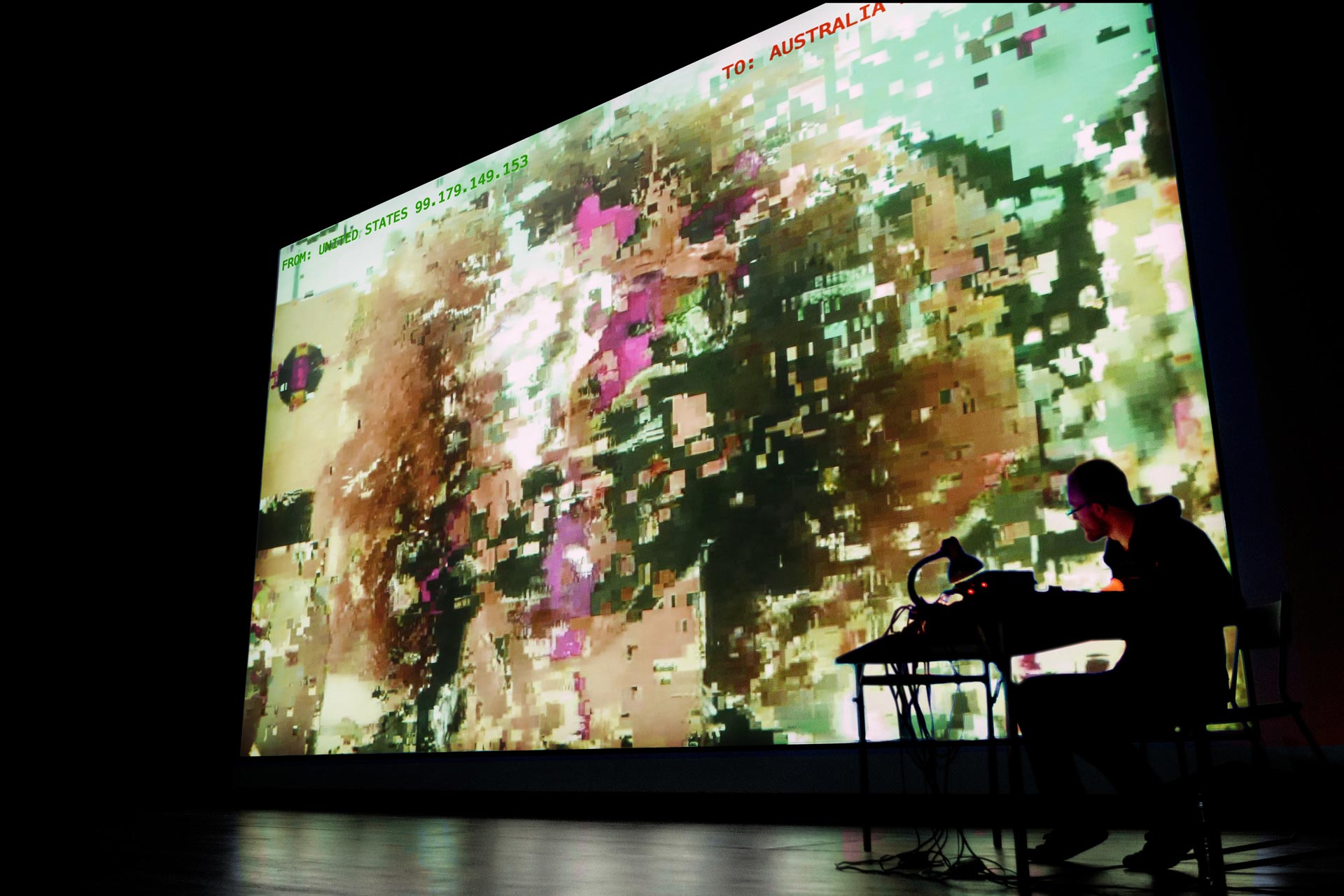
In the context of omnipresent telecommunications surveillance, The Pirate Cinema makes visible the hidden activity and geography of peer-to-peer file sharing. The project is presented as a monitoring room, which shows P2P transfers happening in real time on networks using the BitTorrent protocol.
The installation produces an arbitrary cut-up of the files currently being exchanged. This immediate and fragmentary rendering of digital activity, with information concerning its source and destination, thus depicts the topology of digital media consumption and uncontrolled content dissemination in a connected world.
CONCEPTION: DISNOVATION.ORG
PROGRAMMING: BRENDAN HOWELL & JEAN-MARIE BOYER
INSTALLATION & LIVE PERFORMANCE | 2012–2014
Modded Server Rack Display: Hacking Trust
Simon Denny
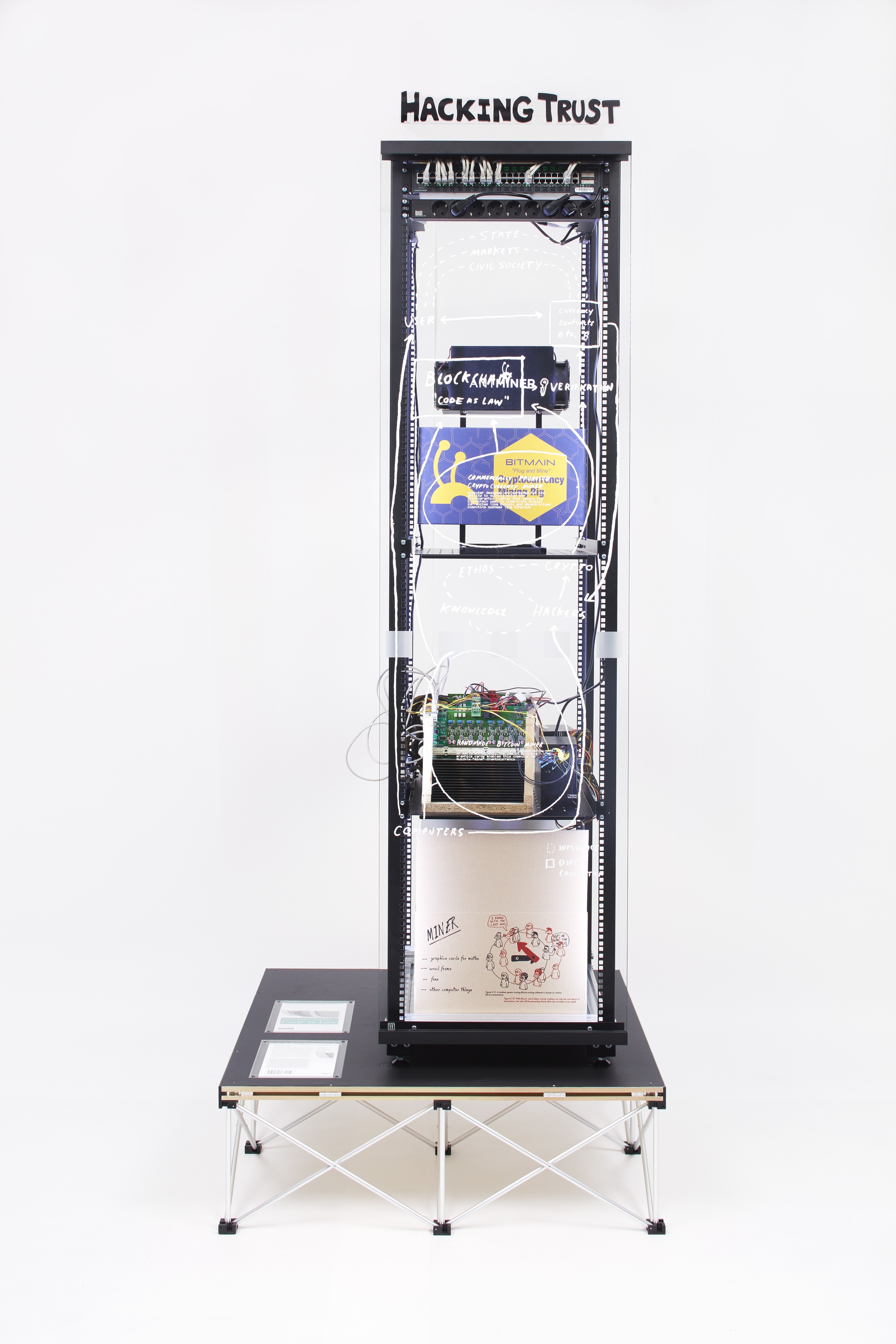
Courtesy of Altman Siegel Gallery
Prints and multiples, Sculpture, Custom printed books in Revostage platform, powder coated 19” server rack, Cisco Systems WS-C2948G switch, LAN cables, Bachmann power strip, steel trays, Bitmain Antminer Golden Sample S3+, handmade Bitcoin Miner Asic Block Erupter Blade SET, UV print on laminated cardboard, UV print on cardboard, laser cut Plexiglas letters, powder coated steel components, UV print on sandblasted laminated safety glass, LED strips
Nested Exchange Series
Harm van den Dorpel

Tree shaped chromosomes ledger exchange.
These specimens find their form by a process of exchanging information with each other. Two works are taken from a determined population and communicate - gossip if you will - by flipping a node of their nested structure. The direction in this process is geared towards the greatest diversity: each specimen wants to be as different from all the other as possible.
As the total amount of information shared among all specimen in the population does not increase over time but is merely recombined towards an optimal diverse distribution, the linear history of state changes (snapshots) can be compared to a blockchain ledger.
The chromosomes of the specimen are stored as nested recursive "tree" structures, similar to those used in language analysis or linguistics.
Plantoid
Primavera De Filippi
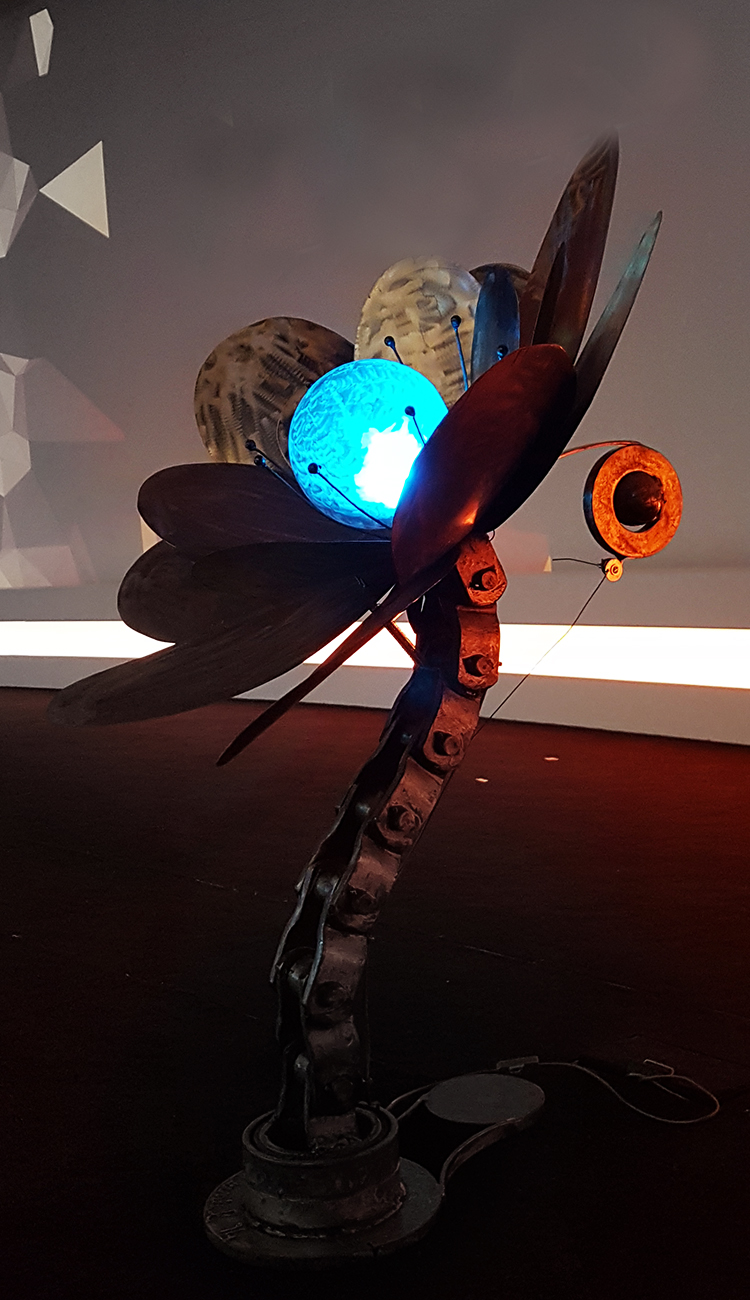
A Plantoid is the plant equivalent of an android; it is a robot or synthetic organism designed to look, act and grow like a plant.
There are currently several species of Plantoids in existence around the world.
This particular species of a Plantoid is an autonomous blockchain-based lifeform that is able to reproduce itself. It is a hybrid creature that lives both in the physical world (as a mechanical contraption made up of recycled steel and electronics) and in digital world (as a software deployed on top of a blockchain-based network).
The goal of the Plantoid is to illustrate one of the most revolutionary—and yet still unexplored—aspects of blockchain technology. It illustrates the ability to create “blockchain-based lifeforms”, i.e. algorithmic entities that are:
autonomous,
self-sustainable, and
capable of reproducing themselves,
through a combination of blockchain-based code and human interactions.
These new types of entities are difficult to apprehend for most people.
Blockchains are decentralized peer-to-peer networks, like Bitcoin, that enable people from all over the world to interact, coordinate, and transact value with one another in a secure and decentralized way. Software code can be deployed on a blockchain-based network to create programs (a.k.a smart contracts) that are run in a distributed manner by all nodes supporting the network. As opposed to traditional software code, run on centralized servers and administered by an online operator, smart contracts can be designed to run autonomously, independently of any central authority or middlemen.
The Plantoid is an attempt at using the artistic medium to illustrate the inner workings of these autonomous systems, so that people can better understand the potential benefits and challenges of this powerful, emergent technology.
Predictive Art Bot
DISNOVATION.ORG

AN ALGORITHM THAT TURNS LATEST MEDIA HEADLINES INTO ARTISTIC CONCEPTS.
In the age of hyperconnectivity, the perverse implications of media echo chambers are becoming more and more obvious. Groups of similar behaviors are being partitioned in filter bubbles, while the few massively reposted topics tends to monopolize most of the available attention. Such insular echo chambers strongly affect ways of thinking, resulting in increasingly homogeneous imaginaries within groups of like-minded people.
Predictive Art Bot caricatures the predictability of media influenced artistic concepts, by automating and skirting the human process of generating ideas. But beyond mere automation, it aims to stimulate unbridled, counter-intuitive and even disconcerting associations of ideas.
To do so, it continually monitors emerging trends among the most influential news sources in fields as heterogeneous as politics, environment, innovation, activism, or health... On this basis, it identifies and combines keywords to generate concepts of artworks in a fully automated way, ranging from unreasonable to prophetic through absurd. Each prediction becomes a thought experiment waiting to be incubated, misused or appropriated by a human host.
CONCEPTION: DISNOVATION.ORG
PROGRAMMING: JÉRÔME SAINT-CLAIR
NATURAL LANGUAGE PROCESSING, WEBSITE, INSTALLATION
PROTOTYPE | 2015–2018
PROOF OF BURN
RIAT – Institute for Future Cryptoeconomics

Money. Value. Wealth. Price. Cost. Abstracts of an economic language that persistently but mistakenly appear as indistinguishable from each other. In an era of increasing digitisation and the automation of money systems, these distinctions become even more obscure. Mysterious narratives about disembodied economies threaten to dominate. PROOF-OF-BURN counters this financial black box and its information asymmetries by demonstrating new modes of organizing mutual trust and material exchange. PROOF-OF-BURN uses the concept of money burning to explore the construction of value and its mediation via cash, digital money and new forms of cryptocurrency. In a series of monetary-technological rituals and artistic interventions in finance, PROOF-OF-BURN demonstrates how forms of money relate to the systems of labor and natural resources that underpin all economies. The performance illuminates the interaction between money, trust, value and economic coordination to reflect on our (crypto)economic condition.
SchellingFlags
Rob Myers

"SchellingFlags" is a blockchain-based system for establishing the aesthetics and allegiances of flags in a decentralized way.
Flags are an intersection and encryption of the political and the aesthetic, an assertion of identity and allegiance. They have proliferated off-chain for social phenomena such as nation-states and genders.
Focal points, also known as "Schelling points", are perceptual phenomena in game theory. They are values or strategies that people will use because they seem obvious or attractive in a given context.
Using the blockchain, SchellingFlags supports the construction and use of flags as ideological focal points for decentralized social co-ordination. Any individual can create and share a flag, and any individual can support it. The most popular flags are displayed by the SchellingFlags graphical interface to provide a map of its ideological landscape.
Tetrapylon
Annie Schneider, Jim Ellis, Jon Phillips, Barry Threw, and #NEWPALMYRA contributors, based on the work of Bassel Khartabil; in collaboration with re:3d and Creative Commons

The Tetrapylon is an archeological monument in Palmyra, Syria, erected during the renovations of Diocletian at the end of the third century.
Together with re:3d, an Austin-based 3D printing company, and Creative Commons, #NEWPALMYRA has produced a 200 pound, 7.5 feet tall 3D rendering of one of the Palmyra Tetrapylons. This version further enshrines this creative realization of the cultural heritage of Palmyra into a cryptocurrency blockchain, distributing it into a global ledger to ensure it lives on.
#NEWPALMYRA, a community platform dedicated to the virtual remodeling and creative use of architecture from the ancient Syrian city of Palmyra, was begun in 2005 by Bassel Khartabil, a Palestinian-Syrian open source software developer, educator, and free culture advocate. Working with the publisher Al-Aous and a team of artists in Damascus, Khartabil began remodeling the endangered ruins of Palmyra in 3D until 2012, when he was unlawfully imprisoned by the Syrian government. Much of this work was never published, though Bassel was committed to its free dissemination and use. In 2015, Khartabil was executed by the Assad regime.
#TokenArt
Alexander Reben
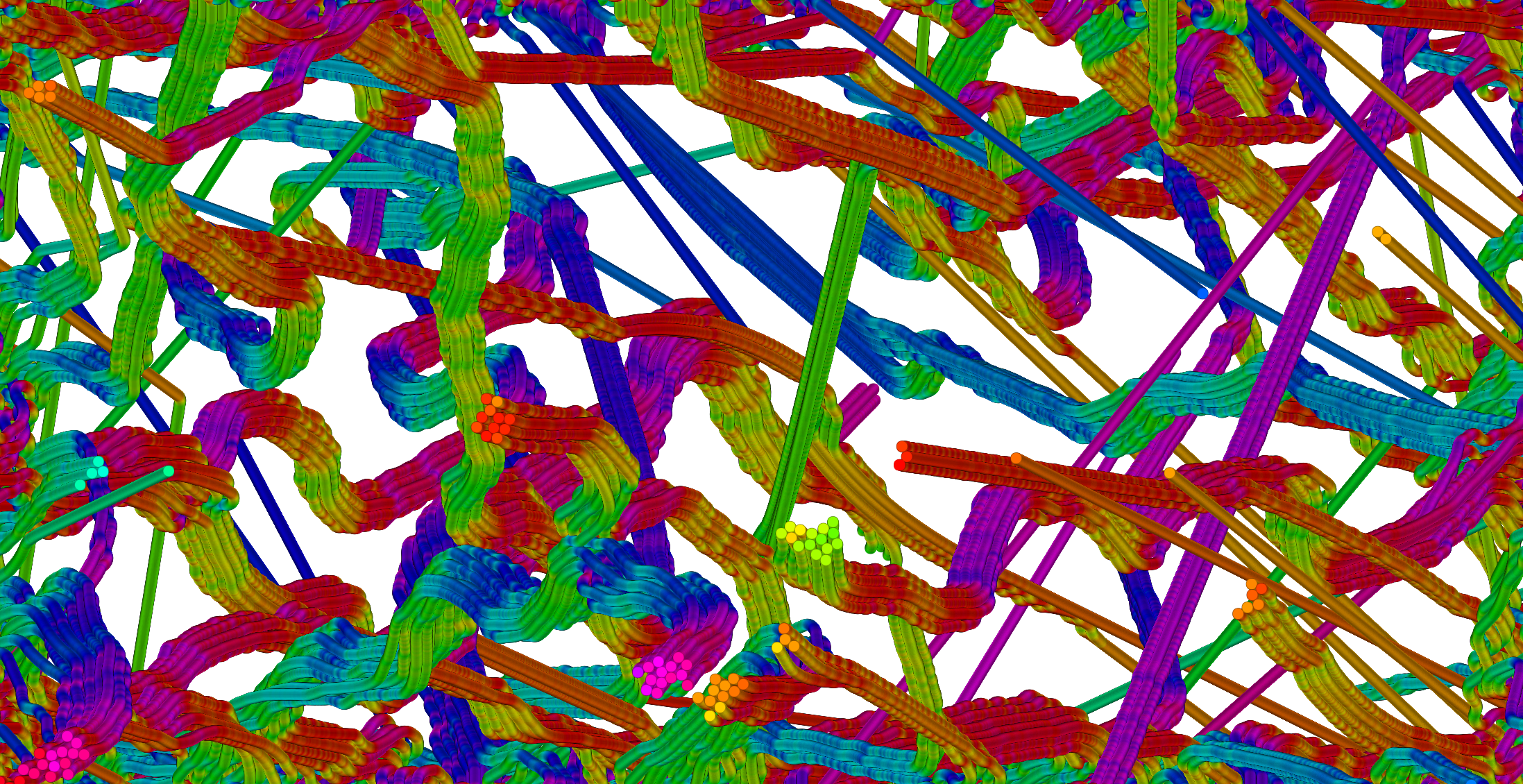
Works from the #TokenArt series allow for the viewer to "develop" their own exclusive but reproducible tangible artwork by way of a physical token linked to a unique intangible identifier.
As the nature of ownership changes in profound ways, the idea of authenticity is becoming ever more relevant. This work investigates these questions by moving the art making activity to the moment of viewing and transitioning the idea of ownership away from a immutable or unique physical output to the seed of the creation itself.